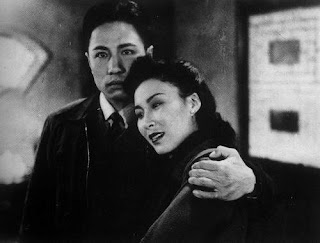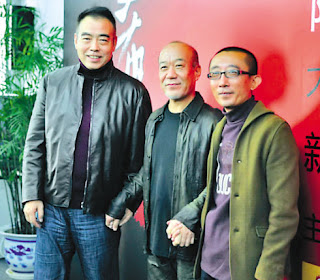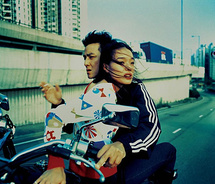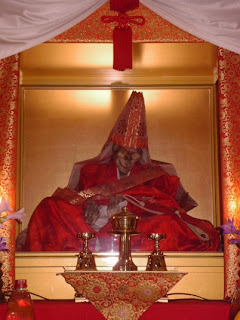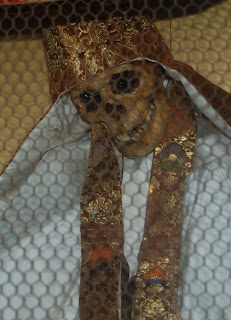 |
| taken down the street from my current home in Uchinoura |
So, in the grand spirit of blogging, as far as I know it, I have taken an extended hiatus from this site. This has largely been due to life circumstances, which saw me depart from just reading about East Asia to actually living there. On the other hand, I had sort of burnt out on the format in which I was keeping this blog. What it was supposed to replicate in my life was the experience of being in an Asian Studies program, exploring various topics in the realm of East Asia, and writing short essays on what I found. Were I actually IN an Asian Studies program, and this site served to supplement or help organize in-class projects, then this might be a viable project. However, I let myself take my writing far too seriously than time allotted, and writing became more of a burden than a pleasure.
Sadly, such is still the case, but recently I've had the want to be posting things on the web, if for no other reason than my own satisfaction. (Well, what other reason has there ever been, I guess?) I'm in no position to do in-depth web crawls to write well-read summaries of my reading; in fact I'm in less of a position than I was when I started this blog, then having a mostly open schedule while now working full time. But, perhaps more importantly, I find no reason to make such posts. I had originally wanted to rehabilitate this blog to keep a cultural journal of readings, but perhaps focus more on current events. However, on the one hand, I'm not well-read enough in the foundational literature to make any sort of insightful reflections on either what is going on in Asia currently, or on the place of a given film or novel in the tradition of East Asian literature.
But that's okay. You know why? Because there are about a thousand blogs that already do this better than I do at present. I'll soon explain why the blog will now be more focused on China, but suffice it to say, I would not make much of a splash in the ocean of blogs on China. If it is Chinese current affairs you are interested in, then you would do well to hit up
China Digital Times or for a more academic/literary blog on China (probably more like what I had in mind for my own), you can check out
China Beat. For information on labor issues, there's
China Labour Bulletin, and for legal issues there's
China Law and Policy or Stan Abram's blog at
China Hearsay, all fine blogs to keep you more than busy at staying up to date with current events. Finally, there's Australia National University's
China Heritage Quarterly that covers a variety of topics in academic format. So if it is Chinese current events you are after, there is no need for one more.
But then, who is the "you" I'm speaking to, anyway? Actually, it makes more sense to treat this blog as a personal link folder for myself to keep track of what I have been reading and following, primarily online. For the most part, especially this year while so much of my time is eaten away by work and studying Chinese, it will make the most sense to just make a serious of short posts, with or without commentary, to articles, essayists, artists and other online sites simply for easy reference in the future. There's been quite a lot lately in the news that I would like to be able to go back and refer to, if only for purposes of conversation. Additionally, at least once a week, if not almost every day, I run across a topic or artist whom I would like to refer back to at some airy future date. Why not post it here so that the one or two friends I have that are also interested in the subject matter can enjoy the same?
Of course, when I have the time or the motivation, perhaps I can write something more close to an article on this or that. Since this blog began as a series of film reviews, right now I think I will take it back to those less ambitious beginnings and initiate a nine month project, designed in part to keep me sane over the coming thirty-something weeks while I am living out my stay in southern Japan. So before I begin posting on Chinese-language film, let me explain that.
Almost a year and a half ago, I left the stultifying town of Athens, Georgia to work as an English teacher at Beijing Language and Culture University. This was just after I finished my MA in Linguistics, and the sense of detachment and self-doubt that left me with was what prompted me to start this blog in the first place. I spent most of my time in Beijing trying to come to grips with what I would do with my future, trying to get my emotions to catch up with my intellect in terms of shifting interests (it seemed, despite day-to-day predilections, I was stuck in a rut of pursuing the same old things), and adapting to life in an overpopulated, heavily polluted city with poor infrastructure and dubious food standards. Early on in that year, I started looking to Japan as an escape route, not only from the grime of Beijing, but from the indecision of what I was most interested in doing with myself. With that in mind, I applied for the JET Program in November of 2010, and jumped through the endless hoops it took to get accepted.
Despite specifying three top preferences for my stay in Japan, I was placed somewhere I had never heard of, far away from anywhere in Japan with which I was familiar: the extreme south of Kyushu, in Kagoshima prefecture on the Osumi peninsula. It is essentially a tropical zone. Being a fan of cold weather, I wasn't thrilled, but thought, hey, this is Japan, the country that has thus far dominated this blog. I will love it, and I will soak up the Japanese language and culture like a sponge. Presciently, in my final weeks in Beijing, I began to sense that maybe I had not properly thought this thing through.
So, after a ten day trip back to the U.S., I left for Japan, with a spectacular but short-lived stay in Tokyo on my way to Uchinoura, Kimotsuki, the tiny town in Kagoshima where I am currently living for nine more months. The place is like some kind of pristine mountainous paradise beside the sea, full of lush fir forests on steep mountain slopes, large expanses of ocean, and absolutely nothing to do with your time. At the same time, it is infested with spiders and centipedes and God know what other fauna that emit loud metallic chirps and screeches during the night.
The major turning point in my life came somewhere toward the end of the first month, however. After a strong initial showing at picking up Japanese during a completely pointless month of "office days" (it was deemed important that I clock in at 8:30 in the morning, sit in an office all day, and clock out at 4:15 Monday through Friday, despite the fact there wasn't a single thing for me to do), I quickly realized that I was not the latent polyglot I always assumed I would be, and that an enormous amount of time is needed not just to crunch vocabulary items, but to keep yourself well enough immersed in a language to not let old words slip out the back door as new ones enter the front. I found myself in the position of once again, for the hundredth time it would seem, letting my newly gained Mandarin skills slide back down that steep slope of language learning in order to learn the language of my my monolingual environment, or else blow off Japanese entirely, facing a year of ostracization, lack of communication, and guilt at both missing a prize opportunity at immersion and offending the people around me.
I chose the latter. Because most importantly, in my daily burnings of nostalgia for my year in Beijing, I realized just how important China, and thus mastering Chinese, is to me, while my interest in Japan, though on the surface ostensibly vast when you consider cinema, music, literature and aesthetics (not to mention sushi), really doesn't hold a candle to my interests in Chinese history, culture, and geography, not to mention tracking China's tumultuous transition into a modern nation of global, consumer culture, which appears to be largely leaving the society
traumatized and soul-searching. My interests in Japan are light, relaxing and fun, but I've found that burdening myself with the task of learning another language, much to my dismay, while still not fully fluent in Chinese, was zapping the fun from those Japanese musings.
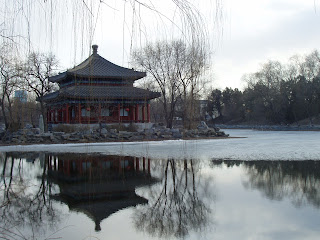 |
| Yuanming Yuan, Beijing |
|
What's more, I was finally able to see how central and integrated a role China has played in my life for the last decade. Suddenly I was tracing a direct thread from reviewing my first hundred characters or so on a bus ride to New York, only the second time I had ever traveled outside the southern U.S., to my marriage, then my sickly trip to China for the first time, through my good friends I made in graduate school and my first experience living outside the U.S. It seems that through most of the important times in my life, studying Chinese has been there in some form or another, even if I largely neglected it or de-emphasized it. Not to mention, not only were issues related to China, especially the tense history of interaction between Han Chinese and minorities like the Tibetans and Uyghurs, the first to really stoke my intellectual fervor in conversation about the world, but while living in Beijing I met people from all over the globe who shared the same interests and passions as I have for the country.
Beijing was filthy. You could not walk on the streets without dodging spit (or worse), or getting honked down by asshole drivers, or harassed by hawkers or panhandlers. Traffic was terrible and its emissions, along with the hyperactive smokestacks of factories around the cities, covered the air in a hazy funk, some days so thick I chose to stay indoors all day. (Though, to be fair, there were long stretches of blue skies that surprised every one from time to time.) Living in Beijing was exhausting, and a trip anywhere, with the requisite hour stuck sandwiched in crowds on the bus or subway, left you angry at the world.
 |
| hutong near Beihai, Beijing |
The town I now live in is clean and the air is cleansing to breathe. While in Beijing my skin would often itch from the dryness in the atmosphere, here it is moist 24/7. There are beaches and mountains and fresh seafood every day. Everyone is so nice you never even have to worry about locking your doors, and everywhere you go you can find solitude and paths to escape to a shrine or alter hidden in the forest. Crime is nothing to speak of, and the government is relatively honest and accountable to the people. While I sense a strong nationalist pride among the people, it is never so flagrant or blind as the nauseating patriotism I constantly encountered in China.
And yet I count down the days until I can leave this sterile environment and return somewhere that I have the ability to immerse myself in Chinese studies, picking back up that thread that has run through what will surely be the most formative, dynamic and chaotic decade of my life. For entirely illogical reasons, I feel like my heart bleeds for China, and no amount of reading or conversation can quell it, at least for the foreseeable future.
 |
| Uchinoura rooftops after a tropical storm |
While I try to make some effort to learn a little Japanese now and then, and I am still interested in the occasional monograph on some aspect of the country or culture, my reading list is quickly growing with titles on the May 4th Movement, the (semi-)sexual liberation of the late 1980's and 90's, the role of women and workers in the modern era, the desperation of China's many famines, especially the state-orchestrated famine of the Great Leap Forward, and as always the plight of the minorities of the west and the Mongolian steppes that live as second-class citizens under Han rule in their ancestral land. This is of course not an exhaustive list, but I only expect it to grow as time passes. Hopefully in two year's time I will be in a PhD program with a reasonably well-defined route through academia, hewn close to the Chinese language in all its facets, but with a healthy slice of cultural/literary studies to indulge the readings that have now taken up so much of my mental space.
In the meantime, to get through these monotonous days in paradise as best I can, I hope to post about 35 movies from mainland China and Taiwan, following a short history of the two nations' cinema. It gives me a way to tick off the weeks while not feeling so isolated from the culture I've come to adopt as my own, so to speak, even if it's taken me a full decade to fully realize the implications of that.
Better late than never, I hope.
 |
| tree above a small altar to Kanno, Uchinoura |
 |
| Shrine entrance in Kouyama, Kimotsuki |



